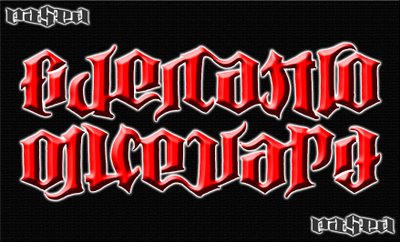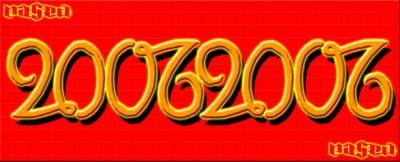Friday, June 30, 2006
 ambigram: mrmiyagi
ambigram: mrmiyagiOne of Singapore's most celebrated bloggers. Done in oriental strokes to complement the Japanese-sounding name. Another popular blogger ambigram.
Thursday, June 29, 2006
 ambigram: berita.harian
ambigram: berita.harianSingapore's only Malay newspaper, another one for the 'local daily' series after this. On their umpteenth revamp.
Roughly translated as 'pulled tea' ('tarek': pull; 'teh': tea), the humble teh tarek is one of the many unique manifestations of the tea in South East Asia. Made with tea leaves (found abundant in this part of the world), hot water, sugar and the quintessential condensed milk, the teh tarek is then 'pulled' to create the signature foamy and frothy 'head'. The perfect any time, any where drink for all ages.
Tuesday, June 27, 2006
 ambigram: germany
ambigram: germany ambigram: argentina
ambigram: argentinaFirst quarter final match: Germany vs. Argentina..
Check out the Spanish version by Alberto Portacio.
Check out the Spanish version by Alberto Portacio.
Monday, June 26, 2006
Saturday, June 24, 2006
Wednesday, June 21, 2006
Tuesday, June 20, 2006
nagfa is the incomplete form of Naguib and Fadilah. Naguib and Fadilah are the incomplete forms of Naguib bin Ngadnan and Fadilah bte Abdul Rahim. Here are the pictures of two very special persons in our lives, persons who make us a little more complete, a little more whole; our real-life heroes :
 Nag and Ayah Ngadnan
Nag and Ayah Ngadnan Fa and Bapak Abdul Rahim
Fa and Bapak Abdul RahimTo all Fathers, nagfa salute you. Happy Fathers' Day!
* 'Ayah' and 'Bapak' are but two (of many) ways of addressing one's father in the Malay culture.
* The head dress worn by Ayah Ngadnan and Bapak Abdul Rahim is called the 'songkok', the shirt-pants combo is known as the 'baju Melayu' and the piece wrapping them around the hip area is the 'kain songket'. This ensemble is usualy worn on special occasions (like a wedding, Hari Raya Puasa: Muslim festival celebrating the end of the fasting month of Ramadhan, etc.).
* 'Ayah' and 'Bapak' are but two (of many) ways of addressing one's father in the Malay culture.
* The head dress worn by Ayah Ngadnan and Bapak Abdul Rahim is called the 'songkok', the shirt-pants combo is known as the 'baju Melayu' and the piece wrapping them around the hip area is the 'kain songket'. This ensemble is usualy worn on special occasions (like a wedding, Hari Raya Puasa: Muslim festival celebrating the end of the fasting month of Ramadhan, etc.).
Monday, June 19, 2006
 ambigram: racial.harmony
ambigram: racial.harmonyAn often-used buzzword in Singapore to describe the 'phenomenon' of how well people from different 'races, languages or religions' can live harmoniously, working closely-knit 'so as to achieve happiness, prosperity and progress for our nation'.
* The main races in Singapore are Chinese, Malay, Indian and Eurasian; just to name a few..
* The Singapore Pledge
* The main races in Singapore are Chinese, Malay, Indian and Eurasian; just to name a few..
* The Singapore Pledge
 reflection: malayalam
reflection: malayalamAnother piece on the mutability of language. Not only is 'Malayalam' the longest palindrome in the dictionary, it also possesses natural symmetry.
Not only that, on closer observation, the word is also made up of another word - 'Malay' - which reads both from the front and from the back.
Malayalam: a language and race of a group of people living in India.
Malay: a language and race of a group of people living in most parts of South-East Asia.
Not only that, on closer observation, the word is also made up of another word - 'Malay' - which reads both from the front and from the back.
Malayalam: a language and race of a group of people living in India.
Malay: a language and race of a group of people living in most parts of South-East Asia.
Saturday, June 17, 2006
 reflection: el.naguib
reflection: el.naguibThe Naguib.
On 'El':
The word 'El' (sometimes 'Al') is equivalent to the English 'the' and functions to separate a particular entity (a noun) from its generic or common group.
The usage of 'El' is shared both by the Spanish speaking communities ('El Nino' basically means The Kid) and those in the Arab world. Historically, 'El' originates from the Arabic language (*'Al-Quran' roughly means The Recital) and was adopted by the Spanish language when Islam entered Spain's Andalucia in 12 Century A.D.
*Just discovered that the word 'Il' used in the Italian language has the same function, too (eg.: 'Il Roche' means 'The Rock')!
*Another two manifestations of 'El', 'Al' and 'Il' can be seen in the French language: 'La' and 'Le' (eg.: 'La Papillon' means 'The Butterfly')!
Language is a wonderful thing; it divides and unites the human race at the same time.
On 'El':
The word 'El' (sometimes 'Al') is equivalent to the English 'the' and functions to separate a particular entity (a noun) from its generic or common group.
The usage of 'El' is shared both by the Spanish speaking communities ('El Nino' basically means The Kid) and those in the Arab world. Historically, 'El' originates from the Arabic language (*'Al-Quran' roughly means The Recital) and was adopted by the Spanish language when Islam entered Spain's Andalucia in 12 Century A.D.
*Just discovered that the word 'Il' used in the Italian language has the same function, too (eg.: 'Il Roche' means 'The Rock')!
*Another two manifestations of 'El', 'Al' and 'Il' can be seen in the French language: 'La' and 'Le' (eg.: 'La Papillon' means 'The Butterfly')!
Language is a wonderful thing; it divides and unites the human race at the same time.
Friday, June 16, 2006
Thursday, June 15, 2006
 ambigram: asmirah-bte-a.rahim
ambigram: asmirah-bte-a.rahimFor Fa's youngest sister.
In the Malay culture, 'bte' (sometimes also 'bt' or 'binti', derived from the Arabic 'Bintu') means 'daughter of'. On the other hand, 'bin' (sometimes 'b', taken wholly from the Arabic 'Bin') means 'son of'. The name which comes after 'bte' or 'bin' is the father's name.
Thus, (chosen merely because of universal familiarity) Osama bin Laden means Osama 'son of' Laden. *The ignorant American usage of referring him as 'Bin Laden' is thus a generic (and wrong) way as the term 'Bin Laden' could easily refer to any one of Laden's sons..
Two persons have the distinction of being contrary to the rule:
1. Prophet Adam (p.b.u.h.) as he is the first man; and
2. Prophet Isa (p.b.u.h. or known also as Jesus in Christianity) as his was of a miraculous birth. His name is hence: Isa bin Maryam (Jesus son of Mary).
In the Malay culture, 'bte' (sometimes also 'bt' or 'binti', derived from the Arabic 'Bintu') means 'daughter of'. On the other hand, 'bin' (sometimes 'b', taken wholly from the Arabic 'Bin') means 'son of'. The name which comes after 'bte' or 'bin' is the father's name.
Thus, (chosen merely because of universal familiarity) Osama bin Laden means Osama 'son of' Laden. *The ignorant American usage of referring him as 'Bin Laden' is thus a generic (and wrong) way as the term 'Bin Laden' could easily refer to any one of Laden's sons..
Two persons have the distinction of being contrary to the rule:
1. Prophet Adam (p.b.u.h.) as he is the first man; and
2. Prophet Isa (p.b.u.h. or known also as Jesus in Christianity) as his was of a miraculous birth. His name is hence: Isa bin Maryam (Jesus son of Mary).
Saturday, June 10, 2006
Friday, June 09, 2006
 ambigram: superman.(superman logo)
ambigram: superman.(superman logo)Another comic book-inspired ambigram incorporating its distinctive logo, after the success of our Bruce-Wayne ambigram.
Monday, June 05, 2006
 ambigram: quran-hadis
ambigram: quran-hadisThe hadis, also known as 'hadith' or 'sunnah', contains the practices and examples of Prophet Muhammad (p.b.u.h) in the life of an ideal Muslim.
".. I leave behind me two things: the Quran, and my example, the Sunnah and if you follow these, you will never go astray.."
- an excerpt from Prophet Muhammad's (p.b.u.h.) Last Sermon, delivered on the ninth day of Dzul Hijjah 10 Hijrah in the Uranah Valley of Mount Arafat.
".. I leave behind me two things: the Quran, and my example, the Sunnah and if you follow these, you will never go astray.."
- an excerpt from Prophet Muhammad's (p.b.u.h.) Last Sermon, delivered on the ninth day of Dzul Hijjah 10 Hijrah in the Uranah Valley of Mount Arafat.









































